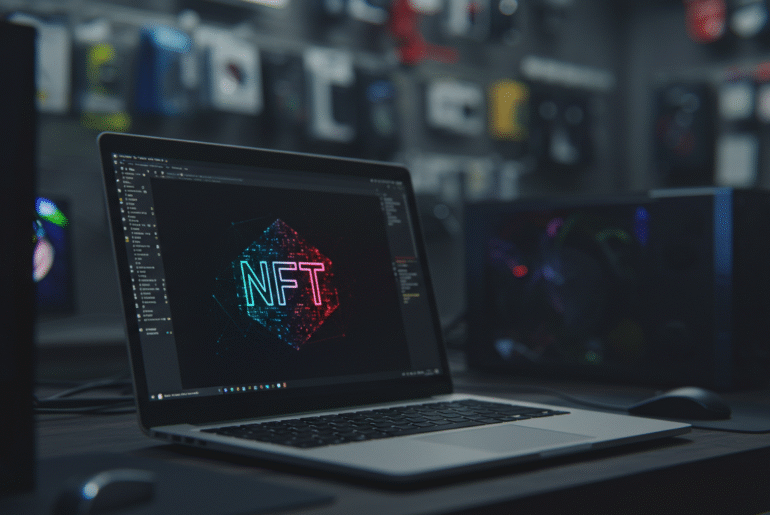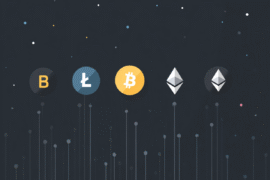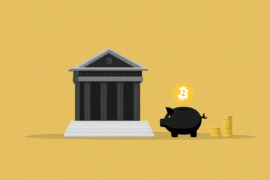This article may contain references to products or services from one or more of our advertisers or partners. We may receive compensation when you click on links to those products or services. Nonetheless, our opinions are our own.
The information presented in this article is accurate to the best of our knowledge at the time of publication. However, information is subject to change, and no guarantees are made about the continued accuracy or completeness of this content after its publication date.
- Jack Butcher Challenges NFT Royalties and Churn Culture
- NFT Royalties and How They Work
- The Churn Effect on NFT Creativity
- Creator Rights and Royalty Concerns in NFTs
- Other Issues Impacting NFT Creator Value
- Jack Butcher’s Proposed Community Model
- Ways to Support NFT Creators and Culture
- Frequently Asked Questions
- Wrapping Up the Future of NFT Creator Compensation
- Recommended Reads
Jack Butcher Challenges NFT Royalties and Churn Culture
An artist sells a digital piece for $500. A week later, it’s resold for $5,000 and then again for $12,000. The creator? They get a 5% royalty on each flip. That’s $575 in total… for a work that now lives in a trading loop, passed like a poker chip between wallets chasing hype.
This is the cycle Jack Butcher wants to disrupt.
In the evolving world of NFTs (non-fungible tokens), Butcher has emerged as a voice of skepticism. While many celebrate royalties as a way for artists to get paid forever, he argues that they feed a culture of churn, a system obsessed with flipping assets instead of appreciating art. As he bluntly puts it, “You’re getting paid on churn.” But what does that really mean, and why does it matter for the future of digital creativity?
NFT Royalties and How They Work
NFT royalties were designed to reward creators every time their work is resold. It’s similar to how musicians earn streaming revenue or authors receive royalties on book sales. Most NFT marketplaces offer anywhere from 2.5% to 10% royalties per resale, automatically distributed via smart contracts.
Sounds fair, right?
Yet Butcher, the creative force behind Visualize Value, Checks, and Open Edition, questions whether these royalties truly support creators or if they merely incentivize short-term speculation. In his view, royalties promote a system where creators benefit from volatility, not value.
The Churn Effect on NFT Creativity
To understand “churn,” imagine buying an NFT at the peak of its popularity. You enjoy the buzz, feel part of the moment and then the hype fades. You sell it. Someone else buys it hoping to do the same. Over and over.
That’s churn.
Butcher argues this cycle treats digital art as a trading instrument rather than a meaningful cultural artifact. Artists, while technically getting a cut, become secondary players in a machine optimized for fast exits. A $1,000 resale may net a $50 royalty, but if that collector only cared about flipping it again, did anyone truly connect with the art?
By prioritizing volume over value, churn culture commodifies creativity. It’s less about the piece and more about timing the market.
Creator Rights and Royalty Concerns in NFTs
The blockchain promised fairness, transparency, and creative autonomy. Yet the NFT space has become increasingly shaped by market behavior rather than artistic recognition. Jack Butcher challenges this contradiction: how can a system built for empowerment result in such fragile creator economics?
In the current model, a creator’s income depends on others continuing to trade their work, not because it’s beloved, but because it’s trending.
Imagine writing a brilliant song but only getting paid if fans resell the MP3. The comparison isn’t far off.
Butcher’s critique goes beyond economic frustration. It calls into question whether NFTs, as currently structured, truly respect the creator. A system rewarding churn over craftsmanship undermines long-term cultural value.
Voted "Best Overall Budgeting App" by Forbes and WSJ
Monarch Money helps you budget, track spending, set goals, and plan your financial future—all in one app.
Get 50% OFF your first year with code MONARCHVIP
Other Issues Impacting NFT Creator Value
While Butcher focuses on royalties and resale loops, broader issues also complicate creator success.
Environmental Concerns
NFTs, especially those initially hosted on proof-of-work blockchains like Ethereum, have been criticized for their carbon footprint. Despite Ethereum’s move to proof-of-stake and eco-friendlier alternatives, many artists still associate NFTs with unsustainable practices, discouraging deeper participation from values-driven creatives.
Legal Grey Areas
Buying an NFT doesn’t automatically grant full rights to the artwork. Most buyers receive a token and limited usage rights, not the copyright. This murky legal territory leads to confusion and sometimes misuse, leaving artists with little recourse unless explicit licensing terms are enforced.
Together, these challenges emphasize Butcher’s view: NFTs must evolve to serve creators more holistically, not just financially, but ethically and legally too.
Jack Butcher’s Proposed Community Model
What if NFT art wasn’t valued by how quickly it could be resold but by how deeply it connected?
Jack Butcher envisions a shift from royalty-dependence to community-driven support. His project Checks was an experiment in digital identity and cultural commentary, challenging users to interpret meaning rather than just chase profits. With the Open Edition, he explored flexibility and minimalism, again centering the experience over the resale.
His takeaway? Sustainable creator ecosystems thrive when there’s emotional and intellectual investment, not just capital speculation.
He champions models where value comes from membership, storytelling, and collaboration, not flipping JPEGs. By encouraging ongoing engagement and meaningful ownership, Butcher suggests creators can build stronger foundations than royalties alone offer.
Ways to Support NFT Creators and Culture
Whether you’re a collector, artist, or enthusiast, here’s how you can help shift the culture away from churn:
- Do Your Research: Look beyond the floor price. Learn about the artist’s vision, background, and contributions to the community.
- Support With Intent: Buy NFTs to connect with a creator or concept, not just to make a quick return.
- Understand Ownership: Know what you truly own (token, image, or license) and respect those boundaries.
- Resist the FOMO Flip: Not every trend needs your wallet. Slow support can be more valuable than fast turnover.
- Engage Directly: Many creators value feedback and connection. Comment on their work. Share it meaningfully. Ask questions.
Frequently Asked Questions
What is Jack Butcher’s stance on NFT royalties?
Jack Butcher believes royalties create a dependency on constant trading, where creators benefit from churn rather than long-term appreciation of their art. He argues this undermines genuine artistic connection and inflates speculative behavior.
Why does he find this problematic?
He believes it prioritizes market activity over the value of the work itself. The focus shifts from creative appreciation to trading cycles, limiting deeper engagement and undercutting the true cultural relevance of the artwork.
What does ‘churn’ mean in the NFT space?
Churn refers to the constant buying and selling of NFTs primarily for profit. It indicates a trading mindset where works are flipped for short-term gains rather than kept for their artistic merit or cultural importance.
What alternatives does Butcher propose?
Jack Butcher advocates for community-led support systems, such as those he developed in his Checks and Open projects. These emphasize connection, participation, and value beyond financial exchange, fostering long-term relationships between artists and collectors.
How has the NFT space responded?
Reactions have been mixed. Some creators embrace Butcher’s model and seek alternatives to royalties, while others defend them as vital income sources. The discussion has prompted exploration of new funding strategies within the NFT community.
Wrapping Up the Future of NFT Creator Compensation
Jack Butcher has sparked a critical conversation in the NFT world, one that transcends code and cash. His critique of royalties and churn culture doesn’t reject blockchain art but reorients it toward integrity, connection, and longevity.
As we move forward, the NFT space must decide: Will it double down on rapid profits or invest in a more sustainable vision where creators are valued not just in resale percentages but as vital cultural contributors?
The choice lies with us all. Will you be part of the churn or part of the change?

Reviewed and edited by Albert Fang.
See a typo or want to suggest an edit/revision to the content? Use the contact us form to provide feedback.
At FangWallet, we value editorial integrity and open collaboration in curating quality content for readers to enjoy. Much appreciated for the assist.
Did you like our article and find it insightful? We encourage sharing the article link with family and friends to benefit as well - better yet, sharing on social media. Thank you for the support! 🍉
Article Title: Jack Butcher Questions NFT Royalties Model
https://fangwallet.com/2025/08/06/jack-butcher-questions-nft-royalties-model/The FangWallet Promise
FangWallet is an editorially independent resource - founded on breaking down challenging financial concepts for anyone to understand since 2014. While we adhere to editorial integrity, note that this post may contain references to products from our partners.
The FangWallet promise is always to have your best interest in mind and be transparent and honest about the financial picture.
Become an Insider

Subscribe to get a free daily budget planner printable to help get your money on track!
Make passive money the right way. No spam.
Editorial Disclaimer: The editorial content on this page is not provided by any of the companies mentioned. The opinions expressed here are the author's alone.
The content of this website is for informational purposes only and does not represent investment advice, or an offer or solicitation to buy or sell any security, investment, or product. Investors are encouraged to do their own due diligence, and, if necessary, consult professional advising before making any investment decisions. Investing involves a high degree of risk, and financial losses may occur including the potential loss of principal.
Source Citation References:
+ Inspo
There are no additional citations or references to note for this article at this time.











































